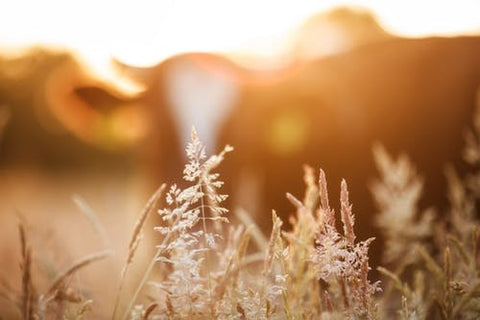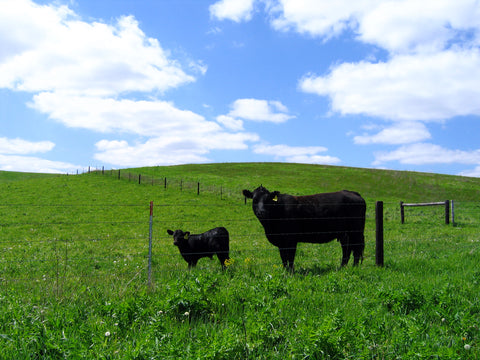Written by: Cassie Holloway, General Manager of The Mill of Whiteford
Summer has officially arrived, and our livestock and horses are feeling it. This time of year, it is vital to keep your animals as cool and comfortable as possible to keep production and performance high. Make sure all animals have plenty of access to shade and cool water throughout the day. If possible, move water troughs under trees or into a shaded area. This will not only help keep your water cooler, but it will also decrease the water lost to evaporation. It will also encourage animals to drink sufficient amounts of water, as they don’t have to leave the comfort of the shade. Increasing the number of water sources is also beneficial, as it provides more opportunity for non-dominant animals to have an access point from which to drink. In your barns, put up fans and open windows to keep the air fresh and moving.
Use caution with letting your animals have access to ponds to cool off. Generally, the animals will defecate in the ponds, which contributes to an increase in bacterial populations. In turn, this can cause issues with udder infections in dairy cows and can result in various other infections if animals have cuts on their legs or feet. Rather than allowing them to stand in a pond, it can be helpful to dampen the barnyard (as long as it’s shaded) to give them a cool place to lay. Pigs love nothing more than a shallow, muddy or water-filled depression to lay in when they get hot, although this does not apply to other livestock species.
Most animals will also decrease their food consumption, both because they don’t feel particularly inspired to eat when they are too hot, and because of the heat produced during digestion. To help with intake, consider changing the times animals are fed to the early morning and late evening hours when ambient temperatures are cooler. Some species respond well to having moisture added to their feed.
If your animals have substantially gone off feed, and you know it’s not the result of a medical condition, consider feeding animals a diet that is more nutrient-dense, allowing them to eat less while still maintaining an adequate nutrient intake. Fat has a lower heat index and a higher energy density than fiber or carbohydrates, making it a good way to account for decreases in feed intake while meeting the requirements for dietary energy. For animals that require a large percentage of dietary fiber, such as cattle, horses, sheep, and goats, make sure it is high-quality fiber which requires less energy and produces less heat during digestion.
As with any changes to diet formulations, make sure the formulations are meeting the nutrient requirements of the animal, including vitamins and minerals. Vitamin and mineral requirements change with the heat, especially electrolytes, even in species that don’t use sweat as their main solution to being over-heated. Talk to a nutritionist or your vet to determine if your animal needs an additional mineral supplement to get through the summer months.
With light-skinned animals, especially pigs, keep an eye out for sunburn. Animals that are highly susceptible should be put inside during the hottest parts of the day, and only let out when the sun is at a lower intensity or during the night. Just ensure they are still receiving sufficient ventilation wherever the animals are placed, and that they have access to cool, freshwater. There are also sunscreen options available, although properly applying them can be tricky.
Flies and other warm-season parasites will also contribute to decreased production and performance during the warm season months. Many grazers won’t leave the relative safety of shaded run-ins or trees during the day in an attempt to avoid flies and heat. Fly control is a vital component to keeping animals comfortable and performing. Options include mineral with feed-through fly control, topical treatments, treated fly strips for mineral feeders, cattle fly rubs and dust bags, insecticidal ear tags for cattle, and barn spray systems.
Feed-through fly treatments are great low maintenance options, but they take longer to work and have a recommended start in early spring in the Mid-Atlantic region, approximately 30 days prior to the beginning of the fly season. Feed-through fly control is not a complete fix by itself, so you’ll need to use other options along with your feed-through program. For cattle and horses, topical treatments are a lower cost option as long as you are able to get close enough to your animals to apply them. Treated strips, rubs, and dust bags are good options if you don’t want to bring your animals in from the pasture just to apply fly control. Remember, the strips, rubs, and dust bags need to be refreshed every so often relative to your herd size and the fly control product being used. Be sure to read the label of any fly control product you use to ensure the product is appropriate for the animal that is being treated and to be certain you’re controlling the pests you need to control.
The biggest goal of an animal manager during the summer months should be to keep his or her animals cool and comfortable. This will help ensure they stay healthy and continue to produce and perform at a high level. It is well worth your time and money to invest in some of the above recommendations. If you need additional help in assessing what practices you might implement into your operation, visit your local feed store. Most have experienced experts on-hand that would love to discuss concerns or questions you may have to get your livestock through the hot summer months. Your local Extension office is another source for valuable information pertaining to managing your animals through the heat of the summer.










